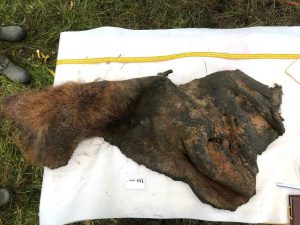Key Takeaways
- Scientists sequenced 40,000-year-old RNA from a Siberian mammoth named Yuka
- This is the oldest RNA ever recovered, revealing active genes at time of death
- The findings show muscle activity patterns suggesting the mammoth was near death
- Technique could revolutionize study of ancient viruses and de-extinction efforts
In a groundbreaking scientific achievement, researchers have successfully sequenced 40,000-year-old RNA molecules from a juvenile woolly mammoth, providing unprecedented insight into the creature’s final moments before death. The discovery marks the oldest RNA ever recovered and sequenced, opening new possibilities for understanding ancient life.
The Mammoth’s Final Hours Revealed
The RNA was extracted from exceptionally preserved mummified leg tissue of a mammoth named Yuka, discovered in 2010 in northeastern Siberia. Of ten tissue samples studied, only Yuka’s provided detailed sequencing data showing which genes were active when the animal died.
Researchers detected both messenger RNA (which codes proteins) and microRNA (which regulates gene activity), revealing the biological processes occurring in the mammoth’s cells right before death. The data showed a predominance of slow-twitch muscle fibers and active proteins related to muscle function.
“We do hypothesize that this animal was close to death, and this is manifested in the metabolism of the muscle,” said lead author Emilio Mármol Sánchez from the University of Copenhagen.
Scientific Breakthrough in Ancient Genetics
While DNA provides the genetic blueprint, RNA reveals which genes are actually functioning in different cell types. This distinction is crucial for understanding how ancient organisms actually operated at the cellular level.
“All the cells in an organism have the same DNA. What makes these cells different from each other is essentially the RNA,” explained senior author Love Dalén from Stockholm University. “It’s about which genes are turned on and turned off in different cell types.”
The research team identified active proteins including titin (for muscle elasticity) and nebulin (for skeletal muscle contraction), providing direct evidence of gene regulation in real time 40,000 years ago.
Future Applications and Limitations
The technique shows promise for studying ancient RNA viruses like those causing COVID-19 and could assist de-extinction efforts by identifying which genes to edit in living relatives of extinct species. Dalén, who advises de-extinction company Colossal Biosciences, noted the method could help narrow down genetic editing targets.
However, the approach currently works only on exceptionally preserved specimens. Only three of ten high-quality mammoth samples yielded RNA fragments, with just one providing detailed data.
“My gut feeling is that methods will improve. There are lots of labs around the world excited about RNA, and I’m sure we’re going to develop much better methods to recover the RNA,” Dalén said.
Historical Context of Ancient RNA Research
While this mammoth RNA is the oldest recovered to date, scientists have previously sequenced RNA from:
- A 130-year-old Tasmanian tiger (2023)
- A 14,300-year-old permafrost-preserved wolf (2019)
- Ötzi the Iceman, a 5,300-year-old Alpine mummy
Independent expert Erez Lieberman Aiden called the research a “significant step forward” but noted it remains unclear whether RNA will become as valuable as DNA for studying extinct organisms.
“These moments are a bit hard to judge,” Aiden remarked, comparing the assessment to predicting a marriage’s happiness from the wedding.





